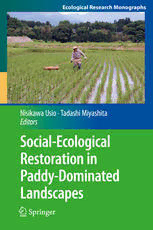Table Of ContentEcological Research Monographs
Nisikawa Usio · Tadashi Miyashita
Editors
Social-Ecological
Restoration in
Paddy-Dominated
Landscapes
Ecological Research Monographs
Series Editor: Yoh Iwasa
More information about this series at http://www.springer.com/series/8852
Nisikawa Usio (cid:129) Tadashi Miyashita
Editors
Social-Ecological
Restoration in Paddy-
Dominated Landscapes
Editors
NisikawaUsio TadashiMiyashita
CenterforTokiandEcological GraduateSchoolofAgriculturalandLife
Restoration(CTER) Sciences
NiigataUniversity TheUniversityofTokyo
Sado,Japan Tokyo,Japan
InstituteofNatureandEnvironmental
Technology(K-INET)
KanazawaUniversity
Kanazawa,Japan
ISSN2191-0707 ISSN2191-0715 (electronic)
EcologicalResearchMonographs
ISBN978-4-431-55329-8 ISBN978-4-431-55330-4 (eBook)
DOI10.1007/978-4-431-55330-4
LibraryofCongressControlNumber:2014958758
SpringerTokyoHeidelbergNewYorkDordrechtLondon
©SpringerJapan2014
Thisworkissubjecttocopyright.AllrightsarereservedbythePublisher,whetherthewholeorpartof
the material is concerned, specifically the rights of translation, reprinting, reuse of illustrations,
recitation,broadcasting,reproductiononmicrofilmsorinanyotherphysicalway,andtransmissionor
informationstorageandretrieval,electronicadaptation,computersoftware,orbysimilarordissimilar
methodologynowknownorhereafterdeveloped.
The use of general descriptive names, registered names, trademarks, service marks, etc. in this
publicationdoesnotimply,evenintheabsenceofaspecificstatement,thatsuchnamesareexempt
fromtherelevantprotectivelawsandregulationsandthereforefreeforgeneraluse.
Thepublisher,theauthorsandtheeditorsaresafetoassumethattheadviceandinformationinthisbook
arebelievedtobetrueandaccurateatthedateofpublication.Neitherthepublishernortheauthorsorthe
editorsgiveawarranty,expressorimplied,withrespecttothematerialcontainedhereinorforanyerrors
oromissionsthatmayhavebeenmade.
Frontcover:Afarmerendeavoringtoremoveagriculturalpestinsectsusingabasketinanorganicrice
paddyfieldinSadoIsland,Japan(photobyNisikawaUsio).Backcover:Left:Anear-threatenedRana
porosaporosa(Tokyodarumapondfrog)foundinaricepaddyfieldadjacenttoanearthenirrigation
ditchinSaitamaPrefecture,Japan(photobyAikoFuruya).Center:Nipponianippon(toki)restingona
tree branchin Sado Island, Japan(photo by HiromuNakatsu). Right:An endangeredRotalapusilla
(mizumatsuba)growinginaricepaddyfieldinTochigiPrefecture,Japan(photobyAikoFuruya).
Printedonacid-freepaper
SpringerJapanKKispartofSpringerScience+BusinessMedia(www.springer.com)
Preface
Anthropogenic activities have led to dramatic loss of biodiversity and ecosystem
servicesworldwide.Amongvariousmanagementpracticesundertakentomitigate
detrimentalimpactsonbiodiversityandecosystemservices,landsparingandland
sharing are two major land management approaches discussed in conservation or
restorationscience(Fischeretal.2008;Tscharntkeetal.2012).Traditionally,much
attention has been given to land sparing, in which relatively pristine areas are
designated as protected areas for biodiversity conservation while human use of
natural resources are restricted in such areas. In recent decades, land sharing, in
which biodiversity conservation and human use of natural resources are practiced
onthesameland,hasgainedequalattention,especiallyinagriculturalecosystems.
Landsparingandlandsharinghavecomplementaryrolesinbiodiversityconserva-
tion or restoration (Fischer et al. 2008), and both land management approaches
complywithashort-term(i.e.,Target7:by2020areasunderagriculture,aquacul-
ture, and forestryare managed sustainably, ensuring conservation of biodiversity)
andlong-term(2050)visions (i.e.,living inharmony withnature)proposedinthe
Strategic Plan for Biodiversity 2011–2020 and the Aichi Targets at the 10th
ConferenceoftheParties(COP10)totheConventionofBiodiversity(CBD2010).
Japanisamongthedenselypopulatedcountries, wherehumans havehadclose
affinity with rural biocultural landscapes, also known as Satoyama. Satoyama
comprises paddy fields, cropland, farm ponds, streams/ditches, secondary forests,
and grassland around villages, where village people have long managed and
maintained natural resources through farming and forestry activities. Many
endemic species, including endangered species, inhabit Satoyama, and organisms
are adapted to moderate levels of disturbances (Katoh et al. 2009). At the same
time, village people have maintained economic activities through farming and
forestry activities. Therefore, Satoyama is believed to be an ideal model system
forlandsharing.
However, Satoyama is facing serious threats from two contrasting types of
habitat degradation: agricultural intensification and abandonment of farmland–
forestry areas (Katoh et al. 2009; Natuhara 2013). Modernization of agriculture
v
vi Preface
led to the use of strong agrochemicals, the associated non-point pollution from
farmland, farmland consolidation, and the associated habitat fragmentation.
In contrast, depopulation and aging in rural communities led to abandonment of
farmland and secondary forests, which in turn accelerated loss of disturbance-
dependent organisms and loss of multifunctionality of such secondary
ecosystems.
In this book, we focus on ecological restoration of paddy-dominated land-
scapes, as rice farming has a major role in Japanese agriculture. To restore
multifunctionality of paddy fields and to revitalize depopulating and aging rural
communities, both ecosystem and human dimensions of ecological restoration
need to be considered. Throughout this book, we have used the term “social-
ecological”to put equal weighton thetwodimensions ofecologicalrestoration.
The only exception is Chap. 2, where “socio-ecological” is used because of the
historyofthatterm’sbeingusedinapoliticalcontext.
Ecological restoration of farmland has attracted much attention from scientists
andpolicymakersinEurope(e.g.,Kleijnetal.2006;Gabrieletal.2009),probably
because farmland accounts for significant proportions of land areas in many
Europeancountries.AlthoughEuropeanscientistsfocusonrestorationofdegraded
dry lands (e.g., cropland or pasture), ecological restoration of paddy fields differs
fundamentally in that it focuses on restoration of quasi-natural wetland habitats.
Our book is the first to introduceecological restoration of paddy-dominated land-
scapes. We hope that this book stimulates further research on social-ecological
restorationinpaddy-dominatedlandscapes.
We thank the authors for submitting chapters for this book; reviewers for their
constructive criticisms on the chapters; N.Yamamura for his helpful comments on
thebook;A.Furuya,H.Nakatsu,M.Nishizawa,andtheSadoMunicipalGovernment
forprovidingphotos;andthestaffofSpringer,Japan,fortheirsupport.
Kanazawa,Japan NisikawaUsio
Tokyo,Japan TadashiMiyashita
References
CBD (2010)The Strategic Plan for Biodiversity 2011–2020and theAichi biodiversity targets.
Availableathttp://www.cbd.int/cop10/doc/default.shtml.Accessed28July2014
FischerJ,BrosiB,DailyGC,EhrlichPR,GoldmanR,GoldsteinJ,LindenmayerDB,Manning
AD, Mooney HA, Pejchar L, Ranganathan J, Tallis H (2008) Should agricultural policies
encouragelandsparingorwildlife-friendlyfarming?FrontEcolEnviron6:382–387
GabrielD,CarverSJ,DurhamH,KuninWE,PalmerRC,SaitSM,StaglS,BentonTG(2009)The
spatialaggregationoforganicfarminginEnglandanditsunderlyingenvironmentalcorrelates.
JApplEcol46:323–333
Katoh K, Sakai S, Takahashi T (2009) Factors maintaining species diversity in satoyama, a
traditionalagriculturallandscapeofJapan.BiolConserv142:1930–1936
Preface vii
Kleijn D, Baquero RA, Clough Y, Diaz M, De Esteban J, Fernandez F, Gabriel D, Herzog F,
Holzschuh A, Johl R, Knop E, Kruess A, Marshall EJP, Steffan-Dewenter I, Tscharntke T,
VerhulstJ,WestTM,YelaJL(2006)Mixedbiodiversitybenefitsofagri-environmentschemes
infiveEuropeancountries.EcolLett9:243–254
NatuharaY(2013)EcosystemservicesbypaddyfieldsassubstitutesofnaturalwetlandsinJapan.
EcolEng56:97–106
TscharntkeT,CloughY,WangerTC,JacksonL,MotzkeI,PerfectoI,VandermeerJ,WhitbreadA
(2012)Globalfoodsecurity,biodiversityconservationandthefutureofagriculturalintensifi-
cation.BiolConserv151:53–59
Contents
PartI UnderstandingAgriculturalSystemsinJapan
1 Japan’sAgriculturalPoliciesAfterWorldWarII:
AgriculturalLandUsePoliciesandProblems. . . . . . . . . . . . . . . . 3
TakuyaHashiguchi
2 Socio-ecologicalSystemsinPaddy-DominatedLandscapes
inAsianMonsoon. . . . . . . . . . . . . . . . . . . . . . . . . . . . . . . . . . . . . . 17
OsamuSaitoandKaoruIchikawa
3 Column:PromotingAgriculturewithaRecognition
ofBiologicalDiversityintheContextofRice
PaddyResolutions. . . . . . . . . . . . . . . . . . . . . . . . . . . . . . . . . . . . . 39
ShinjiMinami
4 DistributionandAbundanceofOrganisms
inPaddy-DominatedLandscapeswithImplications
forWildlife-FriendlyFarming. . . . . . . . . . . . . . . . . . . . . . . . . . . . 45
TadashiMiyashita,MiyuYamanaka,andMasaruH.Tsutsui
PartII RestoringtheMultifunctionalityofPaddy-Dominated
Landscapes
5 EnvironmentallyFriendlyFarminginJapan:
Introduction. . . . . . . . . . . . . . . . . . . . . . . . . . . . . . . . . . . . . . . . . . 69
NisikawaUsio
6 Column:EndangeredSpeciesinJapan:ExSituConservation
ApproachesandReintroductionintheWild. . . . . . . . . . . . . . . . . 87
MarikoKato
ix

